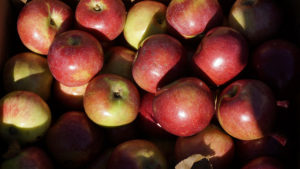Cornucopia’s Take: Farmers with extra food after the harvest often donate to charitable organizations like Second Harvest and local food pantries, making the farms eligible for the Enhanced Federal Tax Deduction. The Natural Resources Defense Council has created a PDF containing helpful information for donating farmers, and we have shared it below.
A FARMER’S GUIDE TO THE ENHANCED FEDERAL TAX DEDUCTION FOR FOOD DONATION
NRDC
 |
In December 2015, U.S. Congress passed legislation to permanently extend an enhanced deduction for tax-paying businesses that donate food to a food bank or other charitable organization. Prior to the change, only C corporations could claim a deduction; now, all for-profit farms can benefit.
CAN MY FARM BENEFIT?
Sole proprietorships, partnerships, corporations, andlimited liability companies (LLCs) can all benefit. If your
farm donates food to a charitable organization (or donated food after 2014) and expects to owe taxes in the following
five years, you can potentially claim a deduction. To claim a deduction, your farm business must generate taxable
income, and you must retain a donation record from the charitable organization.
HOW DO I CALCULATE MY DEDUCTION?
Your deduction is the lesser of:
i. your tax basis for the donated food (generally, your cost) plus one-half of the appreciation (fair market
value minus the tax basis), or
ii. twice your tax basis.
Fair market value is your normal selling price—what your farm charges for food of the same type and quality. You don’t
have to factor in whether you had a buyer, or whether the food meets normal standards for size, shape, etc., as long
as the food is “apparently wholesome.”* You should note that fair market value will vary depending on whether you
intended to sell on the wholesale or retail market.
Let’s go through the calculation:
1. Determine your basis—the amount it cost to grow, buy, or make the food you donated. Smaller farms permitted
to use the cash method of accounting can generally use 25 percent of the fair market value of the donated food
as their basis.
2. Subtract your basis from the fair market value to find the amount of appreciation—meaning the profit you
would have made from selling the food.
3. Calculate your deduction. Divide the appreciation in half and add the basis, or double the basis—the lesser of the
two equals your deduction.
Examples:
John grows apples at a cost of $200. He donates the apples, with a fair market value of $300, to a food bank. His
potential deduction is $200 (basis) plus $50 (one-half of $100 appreciation), or $250. The “twice basis” limitation
does not apply because the $250 amount is less than twice basis (2 x $200, or $400).
If the fair market value of the apples were $700 (rather than $300), John’s potential deduction would be $200
(basis) plus $250 (one-half of $500 appreciation), or $450. However, under the “twice basis” limitation, his deduction is
limited to twice his basis (2 x $200, or $400).
ARE THERE LIMITS TO HOW MUCH I CAN DEDUCT?
Yes. Your deduction cannot exceed 15 percent of your farm’s net income. Also, your charitable contributions cannot
offset more than 50 percent of your adjusted gross income.
WHAT IF MY FARM DOESN’T OWE ANY TAXES THIS YEAR?
You can claim the deduction within five years of your donation. If your farm didn’t make money in the donation
year, or if you donated food in excess of the 15 percent or 50 percent limits, you can carry the deduction over each
of the following five years. You will apply the 15 percent and 50 percent limits until the deduction is used up or five
years expire.
HOW CAN I FIND MORE INFORMATION?
Download the free “Federal Enhanced Tax Deduction for Food Donation: A Legal Guide” by the Harvard Food Law
& Policy Clinic and the University of Arkansas School of Law’s Food Recovery Project.
This document is only a brief summary of the deduction and does not seek to provide legal or tax advice. You should
speak to your accountant or lawyer to learn more about the federal deduction.
* The Emerson Act defines “apparently wholesome” donations as “food that meets all quality and labeling standards imposed by Federal, State, and local laws and regulations even though the food may not be readily marketable due to appearance, age, freshness, grade, size, surplus, or other conditions.” 42 U.S.C. § 1791(b)(2).

